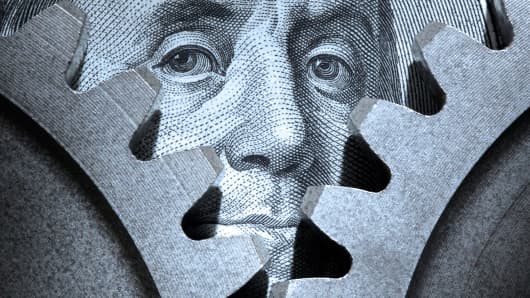The gross domestic product or GDP, is arguably the most important indicator on the health of a country's economy.
So what statistics are used to determine GDP? How does it affect the markets and the average citizen? CNBC explains.
What is GDP?
GDP represents the total dollar value of all goods and services produced over a specific time period. In short, it's everything produced by people and businesses, including salaries of workers.
GDP figures are calculated and released every business quarter by the Bureau of Economic Analysis, which is part of the Department of Commerce. The BEA often revises estimates—either up or down—as it receives better data throughout the next quarter. (More on this later)
Usually, GDP is a comparison to the previous quarter or year. For example, if the second quarter GDP is up 3 ,percent this means that the economy has grown by 3 percent over the first quarter.
How is GDP Calculated?
Measuring GDP is a bit complicated but the calculation can be done in one of two ways—by adding up what everyone earned in a year, or by adding up what everyone spent. Both measures should arrive at about the same total.
The income method is arrived at by adding up total compensation to employees, gross profits for incorporated and non incorporated firms, and taxes less any subsidies from the government.
The expenditure method, which is more commonly used by the BEA, is calculated by adding total consumption, investment, government spending and net exports.
All the statistics for either measurement are gathered by the BEA.
What is nominal GDP and what is real GDP?
This may be a bit technical, but in essence, nominal GDP does not take into account inflation,and real GDP does. But it is an important distinction because this is why some GDP reports get revised.
Nominal GDP measures the value of output during a given quarter or year using the prices of that time period. But the general level of prices can rise due to inflation, leading to an increase in nominal GDP even if the volume of goods and services produced is unchanged. However, the nominal GDP figures won't reflect the increase in prices. This is where real GDP comes in.
The BEA will go back to a quarter or yearly period and measure the value of goods and services adjusted for inflation. This is real GDP. For year over year GDP growth, "real GDP" is usually used, as it gives a more accurate view of the economy.
Both nominal GDP and real GDP statistics are released by the BEA.
How does the GDP affect the average citizen?
When the economy is healthy, there is usually low unemployment and wage increases, as businesses demand labor to meet the growing economy.
However, if the GDP growth rate is speeding up too fast, the Federal Reserve may raise interest rates to stem inflation—or the rising of prices for good and services. That could mean loans for cars and homes would be more expensive. Businesses too would find the cost of borrowing for expansion and hiring to be on the rise.
If GDP is slowing down, or is negative, it can lead to fears of a recession which means layoffs and unemployment and declining business revenues and consumer spending.
The GDP report is also a way to look at which sectors of the economy are growing and which are declining. It can also help gear workers toward training in those sectors that are growing.
How does the GDP affect investors?
Investors look at GDP growth to see if the economy is changing rapidly so they can adjust their asset allocation. A bad economy usually means lower profits for companies, which in turn means lower stock prices for some firms.
The GDP can help determine whether someone might invest in a mutual fund or stock because the health care industry is growing, versus a fund or stock that focuses on technology, which the GDP might say is slowing down.
Investors can also compare country GDP growth rates to decide where the best opportunities are for foreign investment. Most investors like to purchase shares of companies that are in rapidly growing countries.



